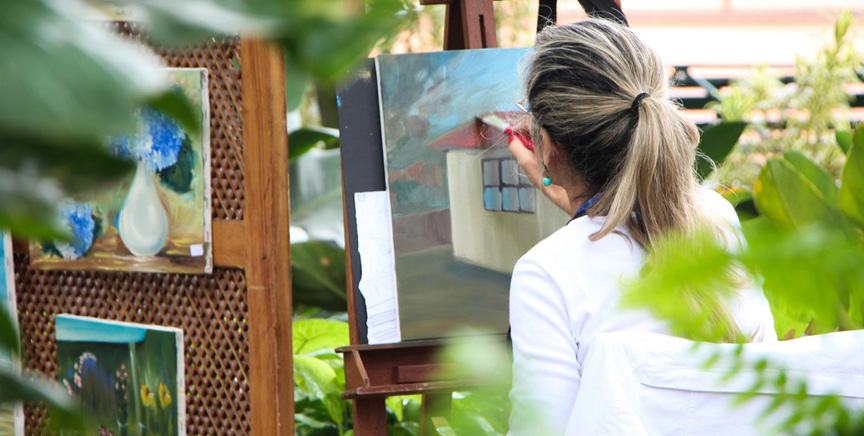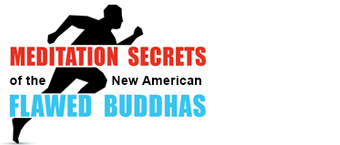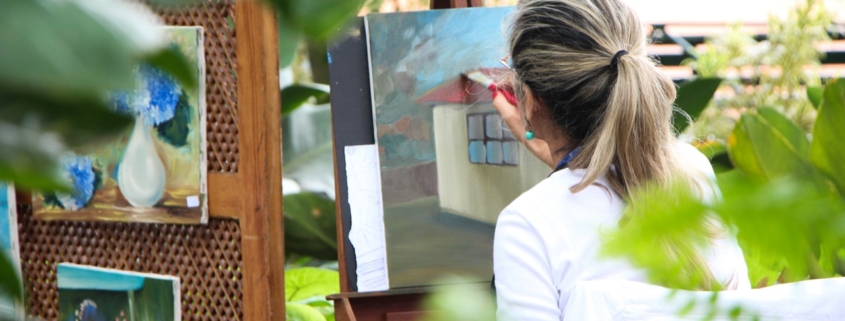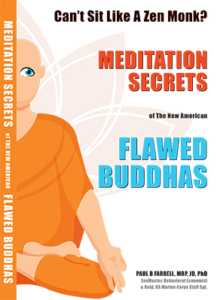Last Updated on September 25, 2020 by Paul Farrell, MRP, JD, PhD

The Fine Arts… Painting, Sculpture, Film, Architecture, Design, Photography… Pure Action Meditating with Your Inner Creator!
“Many of us wish we were more creative. Many of us sense we are more creative, but unable to effectively tap that creativity. Our dreams elude us. Our lives feel somehow flat.
Often, we have great ideas, wonderful dreams, but we are unable to actualize them for ourselves. Sometimes we have specific creative longings we would love to fulfill – playing a piano, painting, taking an acting class, or writing.
Sometimes our goals are more diffuse. We hunger for what might be called creative living – an expanded sense of creativity in our business lives, in sharing with our children, our spouse, our friends.”
– Julie Cameron, The Artist’s Way
Few business and financial executives are as adventurous as Paul Gauguin who traded his position in the Paris banking world for a new life painting in the peaceful island of Tahiti. Most of us stay behind, stuck, afraid, rationalizing, struggling to find some balance, while our creative needs all too often get squeezed into infrequent and brief breaks from the stresses of today’s hectic business world.
Some people, fortunately, do find this balance of “creative living” while actively engaged in the real world. While on Wall Street with Morgan Stanley mine were acting, dance and writing. Here are some other examples.
Churchill and Jung – A Window into the Soul
The Swiss psychologist Dr. Carl Jung painted an unusual series of mandalas over many years. One publisher tried to convince him that “the fantasies arising from my unconscious had some artistic value and should be considered art.” He decided to keep them private, a window into his soul: “At first I could only dimly understand them, but they seemed highly significant, and I guarded them like precious pearls” as he explored his inner self.
Winston Churchill took a less analytical approach: “I paint only for enjoyment” he wrote in his book, Painting as a Pastime; “We cannot aspire to masterpieces. We may content ourselves with a joy ride in a paint-box.” What started “as a lark” became his “constant companion” for over forty years. And very personal, the first public exhibit of his paintings opened late in his life, in France, under an assumed name.
A pastime yes, and an opportunity to meditate. For anyone with a creative right-brain that’s brimming with ideas, sitting silently with your eyes closed is likely to take no more than a few seconds, as a way of meditating on what you want to see appear on the canvass – before launching into the action!
A painter will also be meditating as brushes swirl, as paints are mixed, as pencils are sharpened. Isn’t that what meditation is all about: Focusing solely on what you are doing… on whatever you’re doing in the moment… and only what you are doing? It can take you through an afternoon painting England’s sea coast, as Churchill often did. Or as simple as a moment doodling during a boring business meeting, or sketching birds in a local park after a lunch break.
You Find Peace-of-Mind in “The Doing”
“A sketch can take five minutes or an hour; it can be full of detail or sparse in line,“ says Dr. Patricia Monaghan and Eleanor Viereck, “Neither time nor appearance are important in using natural sketching as a meditation. What is important is the process: focused looking, combined with hand motions that activate the right side of the brain, lead to a sense of calm, well-being, and peace.”
In fact, as kids we were all more in touch with this inner artist, until the “real world” distracted us. I would often lose sense of all time sitting for hours in my grandparents’ attic, sketching the presidents, painting pictures of birds or working on some art poster for the prom or other school event. Later I found an outlet in the field of architecture, today I still use search my inner world for clues about the meaning of life, sketching as I write in my personal journals.
Searching with the “Artist Within”
The inner and outer worlds of the professional artists come together in their work, for they know full well that what they are doing is “an outward expression of an inner life in the artist,” as Edward Hopper put it in one of his reflective moods describing what happens to him on a psychological and spiritual level while painting.
Other artists feel it more as a spontaneous, sensory explosion of passion as some inner creative force takes over your body and mind and forces its way to the surface: “I can’t do anything but paint, the paintings just come to me,” says Jackson Pollock.
“When I am painting I am not aware of what I am doing, because the painting has a life of its own.” Picasso put it, “A painting is not the result of working toward a goal, it is a stroke of luck, an experience.” Much the same as it was for Churchill.
The word meditation doesn’t quite capture the experience of the creative artist, but it comes close! Art is their life, all day, every day. Meditation is an inactive process for monks and new age gurus sitting silently doing nothing. On the other hand, the creative spirit in the artist demands action, something deep within needs to be set free, needs to get what’s in the soul onto canvas and paper, clay, stone and steel – and in that process their art is a meditation much like the moving meditations of the Chinese Taoists in Tai Chi and calligraphy.
“The Real You” is in the Art Created
Today there are artists worldwide who teach “Art as Meditation” courses for anyone who might, “on a lark,” want some guidance in reconnecting with the inner artist that we all knew so well as children. For example, Di Skelly Heron, an Australian artist, invites people to her “Art as Meditation” program with these wonderfully warm promises:
- Learn to re-connect with your creative spirit through the medium of painting and to interpret your paintings.
- Understand your relationship to colors and how to use them as a way to communicate with your intuitive self.
- Learn how to create an ongoing dialogue with your inner self through painting journals.
- Break through the ‘intellect versus the imagination’ barrier and paint from your heart not your head.
- Relax and have fun.
Now that should bring a smile to the face of your inner creative self!
University “Art-as-Meditation” Programs
Closer to home you’ll find an extensive “Art-as-Meditation” program at Matthew Fox’s University of Creation Spirituality in Oakland, California. Fox is a priest and a visionary theologian. His program integrates “the wisdom of western spirituality and global indigenous cultures with the emerging scientific understanding of the universe and the passionate creativity of art.”
The Art-as-Meditation curriculum of the University of Creation Spirituality has a course on “Painting as Meditation” integrated with other creative, psychological and spiritual experiences: Tai Chi and yoga, drumming and dance, mask-making, chakras and dream work, and journeys in Native American and African rituals. Their curriculum makes this way of meditating an adventure that will satisfy anyone’s creative urges.
Meditation is “A Joy Ride in a Paint Box”
“Creativity is an experience, a spiritual experience,” says Julia Cameron in her classic The Artist’s Way. In the mind of the painter, the sculptor, and other artists, creativity, spirituality and meditation are not separate things, they are one and the same. “It does not matter which way you think of it: creativity leading to spirituality or spirituality leading to creativity. In fact, I do not make a distinction between the two.”
So it is impossible to distinguish them – between creation, spirituality and meditation – for the process of creating art is spirituality in action and a perfectly natural way to meditate. Winston Churchill would quickly dismiss all the fancy talk about spirituality, creation and meditation. My guess is he’d tell us to just let your creative child have a little fun and take “a joy ride in a paint-box.”
About the Author
Dr. Farrell is a Behavioral Economist. His books include The Millionaire Code; The Millionaire Meditation: Stress Management for Wall Street, Corporate America & Entrepreneurs; The Zen Millionaire; The Winning Portfolio; Expert Investing on The Net; Mutual Funds on The Net; and The Lazy Person’s Guide to Investing.
He also published 1,643 columns on DowJones-MarketWatch and for years was their #1 traffic-generating columnist. Before the Internet, he edited & published FNX: Future News Index, a financial newsletter for stock market traders. Earlier he was a Wall Street investment banker with Morgan Stanley, Executive Vice President of the Financial News Network; and Associate Editor of the Los Angeles Herald Examiner.
He has a Doctorate in Psychology, Juris Doctor, Masters in Regional Planning and Bachelor of Architecture. He worked on the Esalen organic farm and served in the U.S. Marine Corps as Staff Sergeant in aviation computer technology.








